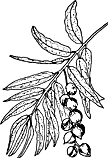| DESCRIPTION A small to medium-sized, upright, evergreen tree reaching 10-18 m in height and a spread of up to 15 m, with ovate leaves, 10-30 cm x 2-4 cm, almost free of spines. Fruit a globose follicle, 2.5-4 cm in diameter, seed (nut) mostly one, globular, with a smooth, hard, thick (2-5 mm) testa enclosing the edible kernel. USES The edible seed eaten as a 'nut' is a source of protein, carbohydrates, calcium, thiamine, riboflavin, niacin, phosphorous, iron, fat and vitamin B1. It is eaten raw or roasted and salted. The decomposed husk is often used in potting soils. It is mentioned as a useful agroforestry species. KILLING T Best adapted to frost-free climate. Affected by frosts in the 0 to -2°C range but mature trees may be tolerant of short periods down to -6°C. Macadamia does not have a true dormant period. GROWING PERIOD Perennial. Grafted trees begins to bear after the 3rd or 4th year, reaches a maximum about the 18th year and is still profitable for 40-60 years or more. May survive up to 100 years. Require 210-230 days from flowering to fruit maturity. COMMON NAMES Macadamia. FURTHER INF It is native to the fringes of subtropical coastal rainforests of southeastern Queensland, Australia and is home in the same type of climate as Coffea arabica. It can be grown from sea level in subtropical areas and at 1000-1600 m in elevation in tropical areas with a prominently seasonal climate. The tree tolerates low relative humidity, and there is no difference in flowering and fruit set between 2 and 40% relative humidity. Strong winds are harmfull due to the brittleness ot the wood. Cool nights induce flowering. Fully-grown trees supply about 45-50 kg unshelled nuts per year and yields of 3-10 t/ha are considered normal. Planting on steep slopes may cause erosion problems, and shelter from strong winds are desirable. |
